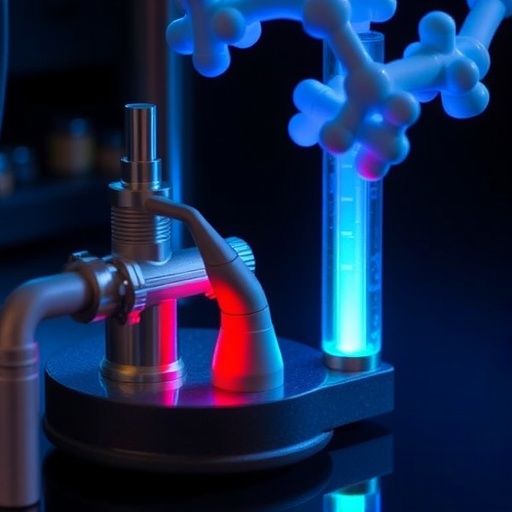In a groundbreaking development in the field of catalysis, researchers have unveiled a novel temperature-dependent mechanistic transition in the oxidation of propylene, facilitated by platinum-ceria (Pt/CeO₂) ensemble catalysts. This discovery, recently published in Nature Communications by Li, Chen, Lv, and colleagues, sheds new light on how catalytic reactions can be finely tuned by simply modifying reaction temperatures, providing substantial implications for industrial oxidation processes and emission control technologies.
The oxidation of propylene, an essential chemical reaction in both environmental and industrial contexts, frequently demands catalysts that not only ensure high selectivity but also maintain efficiency under diverse operating conditions. Traditionally, the mechanistic pathways behind such catalytic processes have been regarded as relatively static under varying thermal regimes. However, this study challenges that notion by revealing that the dominant reaction mechanism in propylene oxidation can pivot dramatically based on temperature fluctuations when using Pt/CeO₂ catalysts.
Central to this research is the unique interplay between platinum nanoparticles and cerium oxide support materials. Platinum, well-known for its catalytic prowess in oxidation reactions, when coupled with ceria, known for its oxygen storage capacity and redox properties, forms an ensemble catalyst system. The synergy between these materials creates reactive sites that can adopt distinct catalytic behaviors depending on thermal energy input, which, as the study reveals, activates different reaction intermediates and pathways.
Using advanced spectroscopic techniques combined with kinetic analyses, the research team observed that at lower operational temperatures, the oxidation process proceeds via a Mars-van Krevelen (MvK) mechanism. This mechanism involves the direct participation of lattice oxygen from the ceria support, which temporarily vacancies are replenished by molecular oxygen from the gaseous phase. It is a pathway that has traditionally been credited for excellent catalytic activity and durability, owing to the dynamic involvement of the oxide support’s lattice oxygen.
However, as the temperature surpasses a critical threshold, the reaction mechanism exhibits a transition toward a Langmuir-Hinshelwood (LH)-type pathway. Here, adsorbed molecular oxygen and propylene species on adjacent platinum sites react without significant lattice oxygen involvement. This thermally induced switch was confirmed through in situ spectroscopy that captured distinct adsorbate species at elevated temperatures, revealing a mechanistic departure from the MvK pathway to an LH mechanism as thermal energy increases.
The implications of this mechano-thermal transition are profound for designing next-generation catalysts. By demonstrating that catalytic activity and selectivity can be dynamically manipulated by temperature, the study highlights an underexplored axis of catalyst optimization. This knowledge allows researchers and industries to envision catalysts specifically tailored for operating windows, enhancing efficiency and reducing unwanted byproducts such as greenhouse gases or unreacted propylene residues.
Moreover, the discovery underscores the importance of cerium oxide as more than a passive support material. Its active role in oxygen supply and redox dynamics enables a catalytic versatility that can be harnessed in designing highly selective oxidation catalysts for various hydrocarbon transformations beyond propylene, such as in automotive exhaust treatment or chemical manufacturing.
From a methodological perspective, the work brings together innovative experimental setups involving temporal analysis of products, temperature-programmed reaction studies, and operando spectroscopic measurements. Such an integrative approach allowed them to unambiguously track the evolution of catalytic phases and surface intermediates under conditions mimicking industrial catalytic reactors, ensuring that the findings bear direct relevance to real-world applications.
Furthermore, the study illuminates the subtle yet critical influence of catalyst ensemble structures, where the spatial proximity of metal nanoparticles and oxide supports governs not only reaction rates but also the predominance of reaction pathways. This insight propels forward the concept of engineered heterojunctions at the nanoscale as a frontier in catalytic science.
In a broader context, this temperature-responsive behavior holds potential in designing smart catalytic systems that adapt their function based on environmental or operational variables. Such systems could operate with enhanced flexibility, self-adapting to fluctuations in feedstock composition, temperature, or pressure, thereby achieving consistent performance without frequent manual intervention or catalyst replacement.
The strategic use of Pt/CeO₂ catalysts also points to a trend in exploiting the redox properties of rare-earth oxides integrated with precious metals to overcome conventional limitations. These composite catalysts not only improve reaction turnover frequencies but also exhibit improved resistance to common deactivation pathways such as coking or sintering under harsh conditions.
This discovery also raises intriguing questions regarding the nature of surface oxygen species on ceria and their interaction dynamics with transition metals under thermal stress. Understanding these relationships at atomic and subatomic levels could unlock further paradigms in catalysis, potentially leading to breakthroughs in clean energy production, selective oxidation processes, and green chemistry synthesis routes.
Notably, the team emphasizes the criticality of catalyst preparation methods, as subtle morphologies and particle distributions significantly affect the observed mechanistic transitions. This highlights the nuanced role of synthesis protocols, aging, and pretreatment in controlling catalyst performance and stability, factors essential for scaling up such materials for industrial deployment.
In conclusion, Li et al.’s recent work represents a seminal advancement in the catalytic oxidation of propylene, revealing the nuanced temperature-dependent switch of reaction mechanisms on Pt/CeO₂ ensembles. This revelation not only enriches fundamental catalysis knowledge but also delivers a clear pathway toward engineering smarter, more versatile catalysts for environmentally and economically vital chemical transformations. As the global demand for cleaner and more efficient catalytic processes escalates, such foundational insights will inevitably catalyze innovation in chemical industries worldwide.
Future explorations inspired by this research may delve deeper into the atomic-scale orchestration of oxygen vacancies, dynamic metal-support interactions, and the generalizability of temperature-induced mechanistic shifts to other catalytic systems. These could pave the way toward the rational design of adaptive catalysts capable of meeting the diverse and evolving needs of sustainable chemical manufacturing.
Subject of Research: Catalytic oxidation of propylene over Pt/CeO₂ catalysts and temperature-driven mechanistic transitions.
Article Title: Temperature-driven mechanistic transition in propylene oxidation over Pt/CeO₂ ensemble catalysts.
Article References:
Li, Z., Chen, X., Lv, Y. et al. Temperature-driven mechanistic transition in propylene oxidation over Pt/CeO₂ ensemble catalysts. Nat Commun 16, 9199 (2025). https://doi.org/10.1038/s41467-025-64243-y
Image Credits: AI Generated




